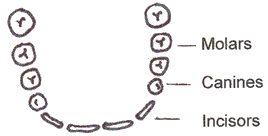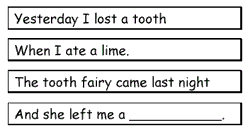This unit includes both primary and intermediate activities for a dental health/teeth study.
- Make a Tooth Model
- Make a Book
- The Tooth Fairy Came Last Night – Poem
- My Teeth Chant
- Play a Game
- Teeth Graph
Make a Tooth Model
You will need: marshmallows and toothpicks
INTERMEDIATE
For older children, supply them with fresh mini-marshmallows and toothpicks. Instruct them to break toothpicks in half and connect 12 marshmallows together with toothpicks, then repeat it. Form both rows into a U shape and stack on top of the other. Put a toothpick through each end to connect and set a folded paper towel between the set. Let set to dry and you’ll have a fine set of choppers.
PRIMARY
For smaller children, make a large set of teeth out of large marshmallows as a class project. Assign some students to flatten marshmallows for incisors, flatten and clip corners of the marshmallows for the canines and indent the molars by pressing a paper wad in the middle. Attach them in the correct order; three molars on the side on the ends, one canine on each side and four incisors across the front. Let dry and use the model to point out how food can get stuck in ridges and spaces. Practice flossing with some yarn.
TYPES OF TEETH – printable version

Make a Book
Copy the tooth book printable page for each child. Instruct them to cut along dotted line and assist them in folding it like card. (Fold top to bottom line, then left side to right.) Discuss the pictures at the bottom and ask them to describe each tooth. Emphasize any words they may need to know for the text.
For early readers, ask them to frame the word big on page one, little on page two, shiny on page three, and loose on page four. Let them glue pictures in correct places and pair them to read the book to a partner.
The Tooth Fairy Came Last Night
PRIMARY-INTERMEDIATE
Read the poem and fill in the blank with the correct coin or dollar amount that rhymes.
Printable: The Tooth Fairy Came Last Night Poem
The Tooth Fairy Came Last Night
Yesterday I lost a tooth
When I ate a lime.
The tooth fairy came last night
And she left me a _______________.
Yesterday I lost a tooth
When I ate a pickle.
The tooth fairy came last night
And she left me a _______________.
Yesterday I lost a tooth
Just like cousin Jenny.
The tooth fairy came last night
And she left me a _______________.
Yesterday I lost a tooth
It fell on the fence.
The tooth fairy came last night
And she left me a _______________.
Yesterday I lost a tooth
It fell on my collar.
The tooth fairy came last night
And she left me a _______________.
EARLY READERS
Copy onto sentence strips the first stanza of the poem, the second line of each stanza, and the words nickel, dime, dollar, fifty cents and penny. Using your large pocket chart, change the second line of the poem with a different sentence strip as you read the stanzas. Let the children use their word analysis skills to chose the word to fill in the blank.

“My Teeth” Chant
Recite this poem with the kids or copy the printable to use for a reading lesson.
My front teeth are for biting.
My bottom teeth are for munching.
My pointed teeth are for tearing.
My back teeth are for crunching!
My incisors are for biting.
My bottom teeth are for munching.
My canines are for tearing.
My molars are for crunching!
Play a Game
Printable: Set of Teeth cards
Provide a Set of Teeth card for each player. Divide children in groups of 4-5 students and supply each with student with 30-40 hardened mini-marshmallows and each group with a number die. Ask students to roll die and place that many marshmallows on teeth. First person to fill in all 32 teeth wins. Discuss that they will have 32 teeth as an adult.
Teeth Graph
Supply children with large graph paper (cut into rows of 3 by 10 squares to save paper), and a scoop full of corn kernels, beans and mini-marshmallows. Ask them to label graph with incisors, canines, and molars. Then let them fill in the graph using marshmallows for incisors, corn for canines and beans for molars. Have them check out their own teeth and make a graph of how many of each they have.
By Susan Payne


Comments are closed.